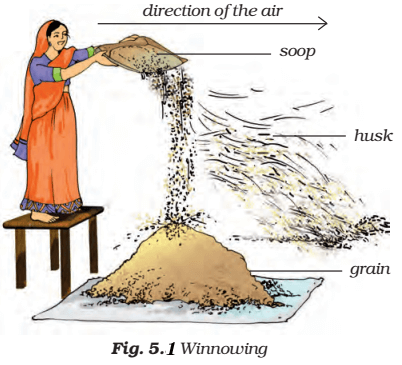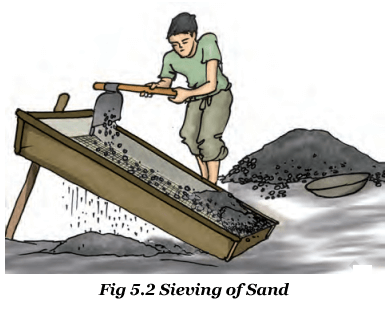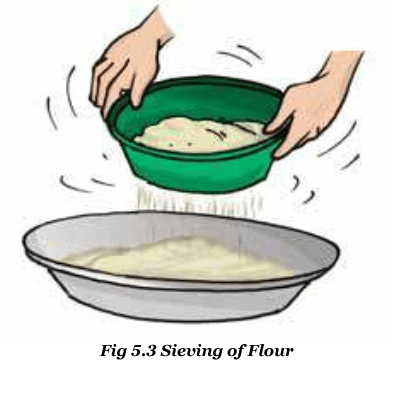NCERT Solutions Class 6 Science
The NCERT Solutions in English Language for Class 6 Science Chapter – 5 (Separation of Substances) has been provided here to help the students in solving the questions from this exercise.
Chapter – 5 (Separation of Substances)
1. Why do we need to separate different components of a mixture? Give two examples.
Answer – Among different components of mixture there are many substances which are harmful or not useful for us. To remove these harmful or unuseful components we need to separate them.
Example :
(a) Tea leaves are separated from the liquid with a strainer while preparing tea.
(b) Stone pieces from wheat, rice or pulses are picked out by hand.
2. What is winnowing? Where is it used?
Answer –
 The process of separation of heavier and lighter components of a mix by wind or blowing air is known as winnowing. Farmers use the method of winnowing to separate husk particles from seeds of grains.
The process of separation of heavier and lighter components of a mix by wind or blowing air is known as winnowing. Farmers use the method of winnowing to separate husk particles from seeds of grains.
3. How will you separate husk or dirt particles from a given sample of pulses before cooking?
Answer – Husk or dirt particles are separated from pulses before cooking by hand-picking.
4. What is sieving? Where is it used?
Answer –
 |
 |
Sieving is a method in which fine particles are sieved through holes of the sieve while the bigger impurities remain on the sieve. It is used in flour mill or at construction sites. In flour mill, impurities like husks and stones are removed from wheat. Pebbles and stones are removed from sand by sieving.
5. How will you separate sand and water from their mixture?
Answer –
Sand and water are separated from their mixture by the following steps:
1. The mixture is allowed to stand without any disturbances.
2. Now sand settles down.
3. Slowly pour the water into another container to obtain sand in the bottom
6. Is it possible to separate sugar mixed with wheat flour? If yes, how will you do it?
Answer –
Yes it is possible to separate sugar mixed with wheat flour by the following method
1. Mix sugar and wheat flour in water.
2. Stir the solution to allow sugar to dissolve.
3. Now filter the mixture.
4. Filtrate contains sugar solution and residue will be wheat flour.
7. How would you obtain clear water from a sample of muddy water?
Answer –
The following process should be carried out to obtain clear water from muddy water
1. Allow muddy water to stand.
2. Mud gets settled down in the water.
3. Slowly pour water to another container
8. Fill up the blanks
(a) The method of separating seeds of paddy from its stalks is called ___________.
(b) When milk, cooled after boiling, is poured onto a piece of cloth the cream (malai) is left behind on it. This process of separating cream from milk is an example of ___________.
(c) Salt is obtained from seawater by the process of ___________.
(d) Impurities settled at the bottom when muddy water was kept overnight in a bucket. The clear water was then poured off from the top. The process of separation used in this example is called ___________.
Answer –
(a) The method of separating seeds of paddy from its stalks is called threshing.
(b) When milk cooled after boiling is poured onto a piece of cloth, the cream (malai) is left behind on it. This process of separating cream from milk is an example of filtration.
(c) Salt is obtained from seawater by the process of evaporation.
(d) Impurities settled at the bottom when muddy water was kept overnight in a bucket. The clear water was then poured off from the top. The process of separation used in this example is called decantation.
9. True or false?
(a) A mixture of milk and water can be separated by filtration.
(b) A mixture of powdered salt and sugar can be separated by the process of winnowing.
(c) Separation of sugar from tea can be done with filtration.
(d) Grain and husk can be separated with the process of decantation.
Answer –
(a) A mixture of milk and water can be separated by filtration. (False)
(b) A mixture of powdered salt and sugar can be separated by the process of winnowing. (False)
(c) Separation of sugar from tea can be done with filtration. (False)
(d) Grain and husk can be separated with the process of decantation. (False)
10. Lemonade is prepared by mixing lemon juice and sugar in water. You wish to add ice to cool it. Should you add ice to the lemonade before or after dissolving sugar? In which case would it be possible to dissolve more sugar?
Answer – Ice should be added to lemonade after dissolving sugar. It is possible to add more sugar before adding ice.
NCERT Solutions for Class 6 Science
- Chapter 1 – Food Where Does It Come From
- Chapter 2 – Components of Food
- Chapter 3 – Fibre to Fabric
- Chapter 4 – Sorting Materials Into Groups
- Chapter 6 – Changes Around Us
- Chapter 7 – Getting to Know Plants
- Chapter 8 – Body Movements
- Chapter 9 – The Living Organisms and Their Surroundings
- Chapter 10 – Motion and Measurement of Distances
- Chapter 11 – Light, Shadows and Reflection
- Chapter 12 – Electricity and Circuits
- Chapter 13 – Fun with Magnets
- Chapter 14 – Water
- Chapter 15 – Air Around Us
- Chapter 16 – Garbage In, Garbage Out

Leave a Reply